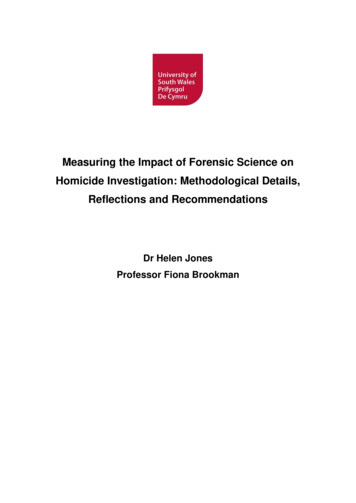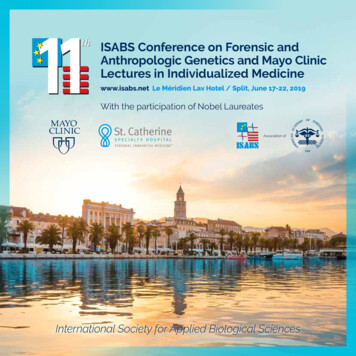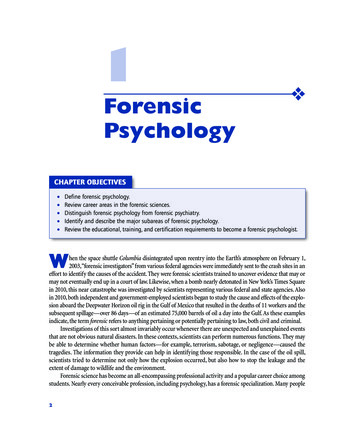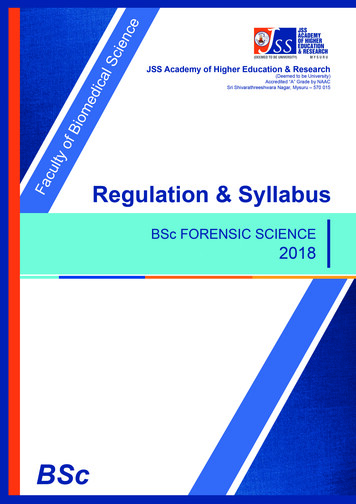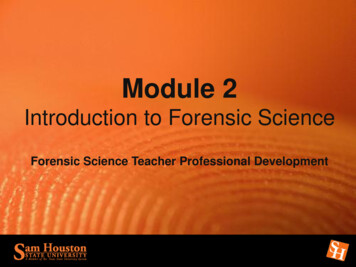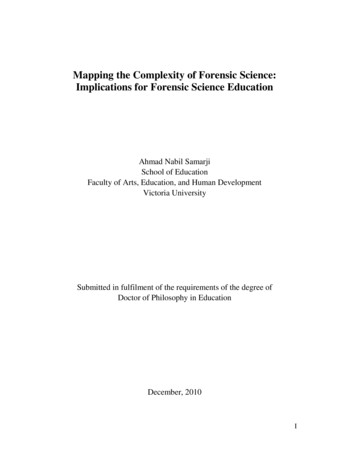
Transcription
Forensic SocialWorkPsychosocialand Legal Issuesin DiversePracticeSettings
About the EditorsTina Maschi, PhD, LCSW, ACSW, is an assistant professor at Fordham University’s Graduate School of Social Service. Her research and practice interests focuson at-risk youth, mental health, juvenile and criminal justice involvement, trauma,mental health, criminality across the lifespan, and community-based researchand evaluation. She is also a licensed clinical social worker with extensive practiceexperience (including the use of creative arts techniques) in correctional, school,and community mental health settings. She currently teaches research and practice courses in the Master’s program at Fordham’s Lincoln Center campus.Carolyn Bradley, PhD, LCSW, LCADC, is an Assistant Professor of Social Workat Monmouth University in West Long Branch, NJ. Dr. Bradley’s research interestsare concentrated in substance use, women, and spirituality. Dr. Bradley has beena clinician maintaining a private practice in clinical social work for over 25 years.Kelly Ward, PhD, LCSW, LCADC, is an Associate Professor at MonmouthUniversity in West Long Branch, NJ, and is also a private practitioner workingwith adolescents with substance-abuse issues. She has been involved with forensicsocial work practice throughout her career.
Forensic SocialWorkPsychosocialand Legal Issuesin DiversePracticeSettingsEditorsTina Maschi, PhD, LCSW, ACSWCarolyn Bradley, PhD, LCSW, LCADCKelly Ward, PhD, LCSW, LCADCNew York
Copyright 2009 Springer Publishing Company, LLCAll rights reserved.No part of this publication may be reproduced, stored in a retrieval system, ortransmitted in any form or by any means, electronic, mechanical, photocopying,recording, or otherwise, without the prior permission of the publisher or authorizationthrough payment of the appropriate fees to the Copyright Clearance Center, Inc.,222 Rosewood Drive, Danvers, MA 01923, 978-750-8400, fax 978-646-8600,info@copyright.com or on the web at www.copyright.com.Springer Publishing Company, LLC11 West 42nd StreetNew York, NY 10036www.springerpub.comAcquisitions Editor: Jennifer PerilloProduction Editor: Pamela LankasCover design: Steve PisanoComposition: International Graphic ServicesEbook ISBN: 978-0-8261-1858-509 10 11 12 / 5 4 3 2 1The author and the publisher of this Work have made every effort to use sourcesbelieved to be reliable to provide information that is accurate and compatible withthe standards generally accepted at the time of publication. The author and publishershall not be liable for any special, consequential, or exemplary damages resulting, inwhole or in part, from the readers’ use of, or reliance on, the information containedin this book. The publisher has no responsibility for the persistence or accuracy ofURLs for external or third-party Internet Web sites referred to in this publication anddoes not guarantee that any content on such Web sites is, or will remain, accurateor appropriate.Library of Congress Cataloging-in-Publication DataMaschi, Tina.Forensic social work : psychosocial and legal issues in diverse practice settings /Tina Maschi, Carolyn Bradley, Kelly Ward.p. cm.Includes bibliographical references and index.ISBN 978-0-8261-1857-8 (alk. paper)1. Social workers—Legal status, laws, etc.—United States. 2. Forensicsociology—United States. 3. Evidence, Expert—United States. I. Bradley, Carolyn.II. Ward, Kelly, LCSW. III. Title.KF8968.7.M37 2009363.25—dc222009021806Printed in the United States of America by Hamilton Printing.
ContentsAbout the Editors . iiContributors.ixPreface . xiiiAcknowledgments . xviiIOverview of Collaborative Forensic PracticeChapter 1Defining Collaborative Forensic Social Work WithDiverse Populations . 3Tina Maschi and Mary Lou KillianChapter 2A History of Forensic Social Work in the United States . 11Mary Lou Killian and Tina MaschiChapter 3Visualizing Forensic Social Work and CollaborativePractice: A Social Justice Systems Approach . 21Tina Maschi and Mary Lou KillianChapter 4Understanding Civil and Criminal Law . 35Christine HeerChapter 5From Intervention Roles to Multidisciplinary Practice . 51Laura Kelly, Nora Smith, and Sandy GibsonIIForensic Practice in Family and Social ServicesChapter 6The Family and Social Work Practice . 63Nancy J. Mezey and Rebecca SanfordChapter 7Social Services: Meeting Basic Human Needsof Income, Food, and Shelter . 81Anne Sparksv
viContentsChapter 8Assisting Female Victims of Intimate Partner Violence:The Role of Victim Advocates . 95Marie MeleChapter 9Forensic Practice With Older Adult Victims of Abuse . 107Janet Mahoney and Morris SaldovIIIForensic Practice in EducationChapter 10Education, Social Work, and the Law . 121Carolyn Bradley, Rosemary Richards, and Regina DoyleChapter 11Building Bridges: School Reentry of IncarceratedJuveniles . 135Lauri Goldkind and Paul HirschfieldIVForensic Practice in Child WelfareChapter 12Child Welfare . 151Nora SmithChapter 13Forensic Interviewing for Child Sexual Abuse. 167Kenneth J. Lau and Eileen C. TreacyVForensic Practice in Mental Health and Substance AbuseChapter 14Mental Health and Addictions: Legal and EthicalIssues for Practice . 183Carolyn Bradley and Kelly WardChapter 15“Order in the Drug Court”: Understanding theIntersection of Substance Abuse and Law . 197Keith Morgen, Lauren Gunneson, and Lisa MaiettaChapter 16Women at Risk: Legal Involvement Among Mothers inAddiction Treatment . 209Nancy M. Violette, Thomas J. Morgan, and Audrey Redding-RainesChapter 17Suicide-Prevention Programming in the Jail Setting . 219Schnavia Smith HatcherVIForensic Practice in Juvenile and Criminal JusticeChapter 18Juvenile Justice and Social Work . 231Tina Maschi, Nancy M. Violette, Nancy Scotto Rosato,and Jennifer Ristow
viiContentsChapter 19Prisons as a Practice Setting. 255Rebecca Sanford and Johanna FosterChapter 20Reentry in the Twenty-First Century . 275Patricia O’BrienChapter 21The Disproportionate Legislative Waiver of MinorityYouth Into the Criminal Justice System. 289Leon Banks, Schnavia Smith Hatcher, and Edward A. RislerChapter 22Restorative Justice: What Social WorkersNeed to Know . 299Katherine van WormerVIIDiversity, Human Rights, and ImmigrationChapter 23Human Rights: Some Implications for Social Work. 313Rosemary A. BarberaChapter 24Calling Some “Illegal”: Practice Considerations inWork With Undocumented Immigrants . 323Carol CleavelandChapter 25Collaborative Forensic Social Work With Refugees . 337Mary Kay Jou and Leah K. LazzaroChapter 26Human Rights Issues and Research With Prisoners andOther Vulnerable Populations: Where DoesEvidence-Based Practice Go From Here? . 349Sandy GibsonAppendicesAppendix AStrengths-Based Psychosocial Assessment (Child Welfare andCommunity Populations and Settings) Example . 361Appendix BRapid Psychosocial Assessment . 367Appendix CPsychiatric Evaluation Example. 373
viiiContentsAppendix DForensic Interviewing Best Practices Example . 375Kenneth J. Lau and Eileen C. TreacyAppendix EMultidisciplinary Example: NJ Anti-Trafficking Coalition. 387Index . 389
ContributorsLeon Banks, PhD, is an instructor with the University of Georgia School of Social Work.Rosemary A. Barbera, PhD, is an assistant professor in the School of Social Work atMonmouth University.Carol Cleaveland, PhD, is an assistant professor in the George Mason UniversityDepartment of Social Work.Regina Doyle, LCSW, has enjoyed dual careers as an educator and a social workerfor the past 35 years.Johanna Foster, PhD, has held various academic positions over the past 15 yearsand has coordinated and taught two postsecondary-education programs for womenprisoners in the greater New York City metropolitan area.Sandy Gibson, PhD, MSW, is an adjunct professor at Temple University.Lauri Goldkind, LMSW, is the Director of Evaluation and Analytics for The UrbanAssembly, a nonprofit school support organization in New York City.Lauren Gunneson, BA, is currently pursuing her master’s degree in ProfessionalCounseling at Monmouth University.Schnavia Smith Hatcher, PhD, is an assistant professor with the University of GeorgiaSchool of Social Work.Christine Heer, Esq, MSW, is an attorney/mediator and collaborative practitionerspecializing in family law, estate planning, and professional responsibility for socialworkers. She also maintains a private therapy practice and is an adjunct professor atSeton Hall University.Paul Hirschfield, PhD, is an assistant professor in the Department of Sociology andthe Program in Criminal Justice at Rutgers University.Mary Kay Jou, MSW, is pursuing her PhD at Rutgers University, and teaches at bothRutgers and Monmouth Universities.Laura Kelly, PhD, APRN, BC, has 15 years of clinical experience working in a community-based substance-abuse program; has worked for 5 years with juveniles in a countydetention center, and for 3 years has been a nurse interventionist working with families.Mary Lou Killian, MSW, PhD, is currently Director of Operations for a communitybased agency for survivors of domestic violence and sexual assault.ix
xContributorsKenneth J. Lau, LCSW, is presently the president of the New York State chapterof ATSA.Leah K. Lazzaro, MSW, LSW, is the Coordinator of Field and Professional Educationin the School of Social Work at Monmouth University.Janet Mahoney, PhD, RN, APN-BC, is an associate professor and associate dean atMonmouth University.Lisa Maietta, BA, is currently pursuing her master’s degree in social work atMonmouth University.Marie Mele, PhD, is an assistant professor with the Department of Criminal Justiceat Monmouth University.Nancy J. Mezey, PhD, is an associate professor of sociology at Monmouth University,where she serves as the Sociology Program Coordinator.Thomas J. Morgan, PsyD, is an assistant research professor at Rutgers University,Center of Alcohol Studies.Keith Morgen, PhD, is an assistant professor of psychology at Centenary College.Patricia O’Brien, MSW, PhD, is an associate professor at the University of Illinois atChicago, Jane Addams College of Social Work.Audrey Redding-Raines, MSW, MPA, is a doctoral student in the School of PublicAffairs and Administration at Rutgers University (Newark).Rosemary Richards, MSW, has been a social worker for 28 years. She worked in thechild protective agencies and the juvenile justice system prior to her experience as aSchool Social Worker/Student Assistance Coordinator.Edward A. Risler, PhD, is an associate professor with the University of Georgia Schoolof Social Work. He was recently appointed for a second term by the Governor ofGeorgia to be a member of the Georgia Department of Juvenile Justice board ofdirectors.Jennifer Ristow is currently earning her MSW at Monmouth University, in West LongBranch, New Jersey.Morris Saldov, PhD, MSW, is an associate professor at Monmouth University in WestLong Branch, NJ.Rebecca Sanford, PhD, is Assistant Professor in the Department of Communicationat Monmouth University. She has 10 years experience as an instructor and programadministrator for education programs administered to male and female incarcerated students.Nancy Scotto Rosato, PhD, is a research scientist at the New Jersey Department ofHealth and Senior Services.Nora Smith, PhD, LCSW, has taught at Monmouth University for 8 years and is thecoordinator for the Post Master’s degree in the Play Therapy Program.Anne Sparks, PhD, is an assistant professor in the Department of Social Work atOhio University.
ContributorsEileen C. Treacy, PhD, is co-founder of Bronx Women Against Rape, and founder ofthe Kingsbridge Heights Community Center’s Child Sexual Assault Counseling andPrevention Program.Katherine van Wormer, PhD, is a professor of social work at the University of Northern Iowa.Nancy M. Violette, PhD, LCSW, LCADC, is an assistant professor at RutgersUniversity, Center of Alcohol Studies.xi
This page intentionally left blank
PrefaceSocial workers are found in most community and institutional settings, includingsocial services agencies, schools, hospitals, substance-abuse and mental health programs, child welfare agencies, and courts and prisons throughout the world. Regardless of the location of practice, to be effective practitioners social workers must sharecommon professional needs. We need to have the skills to assist and empower clientswho may be struggling with an array of problems, including legal issues, unfairpolicies, and/or lack of legal protections. We also must be able to work collaborativelywith other professionals and stakeholders to help clients sort through a mixture offinancial, psychological, emotional, social, and legal concerns.This book targets the important and emerging practice area of forensic socialwork, an area that is often overlooked or misunderstood. The book builds on priorwork in this area by providing a broader view of forensic social work to include theknowledge and skills needed to practice effectively with clients in the sociolegalenvironment. We define “forensic social work” to include not only a narrow groupof victims and offenders involved in the juvenile justice and criminal justice settings,but all the individuals and families involved with family and social services, education,child welfare, mental health, and addictions programs, in which they are affected byfederal and state laws and policies. Examples include social workers advocating forlegal protections for undocumented workers, those assisting individuals and familiesin need as they apply for entitlements such as Medicare or Social Security disabilitybenefits, and those providing mental health treatment to inmates with special needsin a correctional setting.This book fills a critical gap in social work education. Interdisciplinary practiceand legal knowledge are essential for social workers to ensure that clients are effectivelyserved. Yet the implications of legal issues are rarely addressed and/or integrated insocial work education in a meaningful and practical way. This book addresses thisperceived oversight. This volume, made up of 26 chapters written by forensic professionals, enlightens readers with state-of-the-art, practical knowledge in collaborativeforensic social work practice. Readers of the book will become more confident andcompetent in integrating sociolegal knowledge and skills, especially collaboration andadvocacy, into their professional practices.OrganizationForensic Social Work is structured so that the reader can make the most of its contents.It is divided into seven parts that move from the broad discussion of collaborativeforensic practice to specific fields of practice. Part I, Overview of Collaborative Forensicxiii
xivPrefacePractice, prepares the reader with a definition of collaborative forensic social workpractice. Assuming a social justice systems approach, we define this specialty practicearea to include all practice fields that operate in the sociolegal environment. Thesefields range from social and mental health services to the juvenile and criminal justicesystems. Readers are guided on a journey through the history of forensic social workfrom its roots in the charity and corrections movements to its current manifestationas the work of professional clinicians and policy advocates. The use of a social justicesystems approach helps readers visualize their practice within the sociolegal system.A comprehensive description of civil and criminal law helps readers understand thelegal issues and court proceedings that affect clients and professional practice. Thissection concludes with a discussion of multidisciplinary practice, which providespractitioners with knowledge and skills that can be applied to any field of practice.In Parts II through VI, readers are introduced to specific fields of practice affectedby the sociolegal environment. In these sections, readers learn what it means to uselegal knowledge and skills in practice areas, such as family and social services, education, child welfare, mental health and addictions, juvenile justice, criminal justice,and immigration systems. Readers also have the opportunity to hear from seasonedpractitioners and experts about the types of clients or practice issues they may encounter in a specific practice field.Part II, Forensic Practice in Family and Social Services, begins with an overviewof which is followed by a discussion of forensic practice with female victims of partnerviolence and older adults victims of abuse. The educational system is another areain which social workers must know federal and state policies and other service systemsthat influence their students’ success. Part III, Forensic Practice in Education, addressesthe relationship between school social work and the law. The unique school reentryneeds of juveniles being released from secure care in the juvenile justice system arealso addressed.As clients’ problems become more serious, such as child maltreatment and neglect,social workers often become involved in the child welfare system. Part IV, ForensicPractice in Child Welfare, tackles specialized practice in the child welfare system. Itprovides readers with an overview of this system as well as a detailed account of thetheory and practice of forensic interviewing with alleged victims of child sexual abuse.Mental health and addictions are practice areas filled with legal quagmires. PartV, Forensic Practice in Mental Health and Substance Abuse, helps prepare socialworkers in this arena by making readers aware of the psychological, social, and legalissues affecting their clients and their professional practice. This section addresses theknowledge and skills required for practice with clients presenting with mental healthand/or addiction issues in the community and the criminal justice system. Specializedtopics addressed include social work practice with drug-court-involved clients, mothers in addictions treatment at risk of criminal justice involvement, and suicidal clientsin jail settings.In Part VI, Forensic Practice in Juvenile and Criminal Justice, readers learn aboutsystems traditionally associated with forensic social work. Social workers in thesesystems often work with clients who have a multitude of social, psychological, financial, and legal issues involving delinquency or a criminal law violation. Three chaptersprovide insiders’ portraits of the continuum of care for juveniles and adults that rangefrom the courts to prisons to community reentry. Social justice issues, such as thedisproportionate waiver of minority youth into the adult system, as well as the useof the restorative justice approach for victims and offenders are highlighted.
PrefaceThe book concludes with Part VII, Diversity, Human Rights, and Immigration.A detailed discussion linking human rights to forensic social work is presented. Specialtopics, such as social work practice with undocumented workers and refugees andvictims of human trafficking, prepare social work practitioners to address the diversesociolegal needs of these clients.After reading this book, social workers will be better positioned to intervene withclients within and across various fields of practice. They will also be better preparedto integrate specialized knowledge and skills in interdisciplinary collaboration withother professionals. Additional resources found in the book enable the lifelong learningprocess of forensic social work practice with a variety of populations across a widerange of practice settings.xv
This page intentionally left blank
AcknowledgmentsThere are many people who helped shape this book idea into a reality. We are mostindebted to the practitioners and clients who shared their experiences. Special thanksare extended to David Estrin and David Follmer for their editorial words of wisdom.We also acknowledge Professor Reba Brown and her undergraduate students at theUniversity of North Carolina-Charlotte for adopting a draft version of this manuscript.The feedback provided by Professor Brown and her students was invaluable. We alsothank our friends and family members for making this collaborative effort easier. Wehope you know who you are!xvii
This page intentionally left blank
Part IOverview ofCollaborativeForensicPractice
This page intentionally left blank
DefiningCollaborativeForensic SocialWork With DiversePopulations1Tina MaschiMary Lou KillianAs a professional social worker, inevitably you will encounter diverse individuals,families, or communities affected by social/environmental and legal issues. Poverty,homelessness, parental divorce, exposure to family or community violence, and juvenile or criminal offending are just some of the hardships clients face. Frontline socialworkers in a variety of settings (e.g., community-based child and family services,health care, education, child welfare, mental health, substance abuse, social services,juvenile justice, and criminal justice systems) interact daily with clients who havemultiple problems, including legal ones. For example, a social worker may have aclient who is a single father facing allegations of child neglect. He knows little aboutthe child welfare policies and laws affecting his family or how to navigate the courtsystem. Thus, it is imperative that social workers supplement their specialized practiceexpertise with knowledge of the laws and policies that influence their client populations. The practice of collaborative forensic social work is ideal because social workersare positioned to take action in a sociolegal environment.We argue that all social workers across all fields of practice, not just those injuvenile and criminal justice settings, often assist clients affected by laws and policies3
4Part I Overview of Collaborative Forensic Practice1 1A broad definition of social work.or problems in accessing resources. Therefore, it is imperative that practitioners integrate their understanding of collaboration, the law, and specialized skills with generalist social work practice. This book will help prepare practitioners with the knowledge,values, and skills to navigate the social and legal issues that affect clients.We also argue that effective, collaborative forensic social work practice requiresa two-pronged approach to helping clients. This dual approach involves interveningwith clients on both an individual level to address a client’s social well-being (e.g.,referral to mental health counseling) and/or at the legal or policy levels (e.g., representing a youth in court as a child advocate or participating in lobbying efforts to advocatefor legislation that addresses special population needs). We define collaborative forensic social work as an integrated (i.e., generalist, specialized, and collectivistic) approach tosocial work practice with diverse populations across diverse practice settings in the sociolegalenvironment. Figure 1.1 illustrates this definition. This figure depicts a broad definitionof forensic social work that integrates the knowledge and skills of generalist andspecialized social work, forensic social work, and collaboration. We refer to this specialty area as “collaborative forensic social work.”The integrated role of collaborative forensic social workers allows us to assumemultiple professional roles, functions, and activities. This strategy is designed toimprove clients’ social functioning and environmental conditions through collaboration with clients, professionals, and other stakeholders within and across differentsystems of care. The “forensic” or “legal” aspect of the work situates social workersin a position to honor their professional commitment to social justice through the useof legal knowledge and skills, including advocacy and policy practice.
Chapter 1 Defining Collaborative Forensic Social Work With Diverse PopulationsDefinitionsGeneralist Social WorkEmbedded in our definition of collaborative forensic social work are the generalprinciples of social work practice, such as the International Federation of Social Work’s(IFSW) definition. According to the IFSW:The social work profession promotes social change, problem solving in human relationships,and the empowerment and liberation of people to enhance well-being. Utilizing theoriesof human behavior and social systems, social work intervenes at the points where peopleinteract with their environments. Principles of human rights and social justice are fundamental to social work. (IFSW, 2000)Forensic Social WorkThere are a number of definitions of forensic social work. They range from generalto specific and they may focus on one or more practice settings or populations. Forexample, Barker and Branson (2000) placed forensic social work in a broad “legal”environment, and they defined it as a “professional specialty that focuses on theinterface between society’s legal and human service systems” (p. 3). In contrast, Hughesand O’Neal (1983) defined forensic social work as specifically relating to the intersection of mental health and law, in which social workers “function in this space in whichmental health concepts and the law form a gestalt” (p. 393). Roberts and Brownell(1999) described forensic social work in terms of the knowledge and skills needed forthe specific populations served, particularly victims and offenders. In this case, forensicsocial work is the “policies, practices, and social work roles with juvenile and adultoffenders and victims of crime” (p. 360). In comparison, Green, Thorpe, and Traupmann (2005) defined forensic social work more broadly as “practice, which in anymanner may be related to legal issues and litigation, both criminal and civil” (p. 1).Barker (2003) and the National Organization of Forensic Social Workers (1997)provide even broader definitions of forensic social work. Barker’s definition addressesboth civil and criminal law issues:The practice specialty in social work that focuses on the law, legal issues, and litigation,both criminal and civil, including issues in child welfare, custody of children, divorce,juvenile delinquency, nonsupport, relatives’ responsibility, welfare rights, mandated treatment, and legal competency. Forensic social work helps social workers in expert witnesspreparation. It also seeks to educate law professionals about social welfare issues andsocial workers about the law. (p. 166)On their Web site, the National Organization of Forensic Social Work (NOFSW)(1997) offers the broadest definition:Forensic social work is the application of social work to questions and issues relating tolaw and legal systems. This specialty of our profession goes far beyond clinics and5
6Part I Overview of Collaborative Forensic Practicepsychiatric hospitals for criminal defendants being evaluated and treated on issues ofcompetency and responsibility. A broader definition includes social work practice whichin any way is related to legal issues and litigation, both criminal and civil. Child custodyissues, involving separation, divorce, neglect, termination of parental rights, the implications of child and spouse abuse, juvenile and adult justice services, corrections, andmandated treatment all fall under this definition. (para 1)For more on the ethical issues of social work, see chapter 4, “Understanding Civiland Criminal Law.”CollaborationAs the various definitions suggest, social workers who practice in a sociolegal environment must be well versed in collaboration. This includes working with other professionals (e.g., attorneys, doctors and nurses, and victim advocates), law enforcementpersonnel, and clients, family members, and other stakeholders.Historically, social workers have practiced in a variety of “host” agency settings,such as hospitals, schools, industries, psychiatric clinics, police departments, and courtand criminal justice settings (Brownell & Roberts, 2002; Jansson & Simmons, 1986).(See chapter 2, “A History of Forensic Social Work in the United States.”) With theincreasing intricacies of social problems and dwindling resources, social workers’involvement in interdisciplinary collaboration within and across agencies is oftenunavoidable (Bronstein, 2003; Graham & Barter, 1999; Guin, Noble, & Merrill, 2003;Payne, 2000).In particular, forensic social workers often work with interdisciplinary teams.When they do, the elements of interdisciplinary team practice often consist of: a group of professionals from different disciplines,a common purpose,the integration of various professional perspectives in decision making,interdependence,coordination and interaction,communication,role division based on expertise (Abramson & Rosenthal, 1995).The ability to work interdependently with others is critical to achieving successfulclient outcomes. As Bronstein (2003) noted, interdisciplinary collaboration is an “effect
Thomas J. Morgan, PsyD, is an assistant research professor at Rutgers University, Center of Alcohol Studies. Keith Morgen, PhD, is an assistant professor of psychology at Centenary College. Patricia O'Brien, MSW, PhD, is an associate professor at the University of Illinois at Chicago, Jane Addams College of Social Work.

